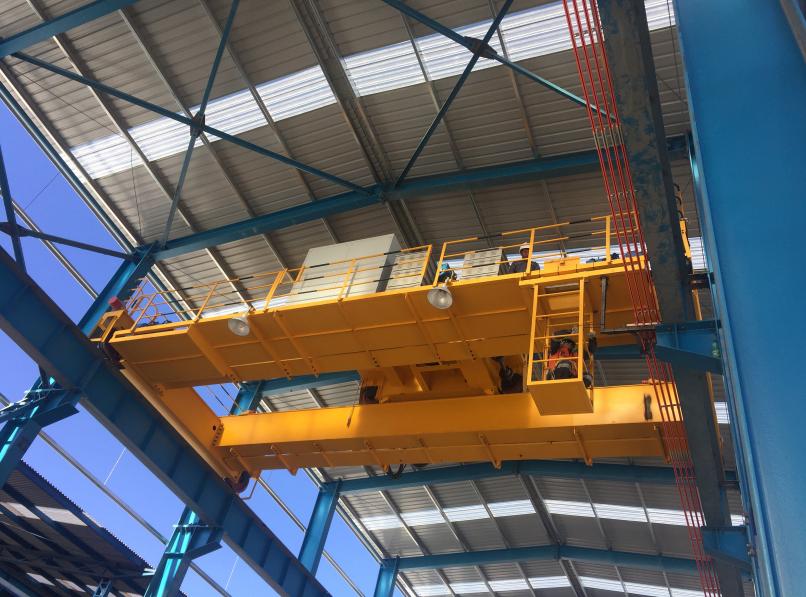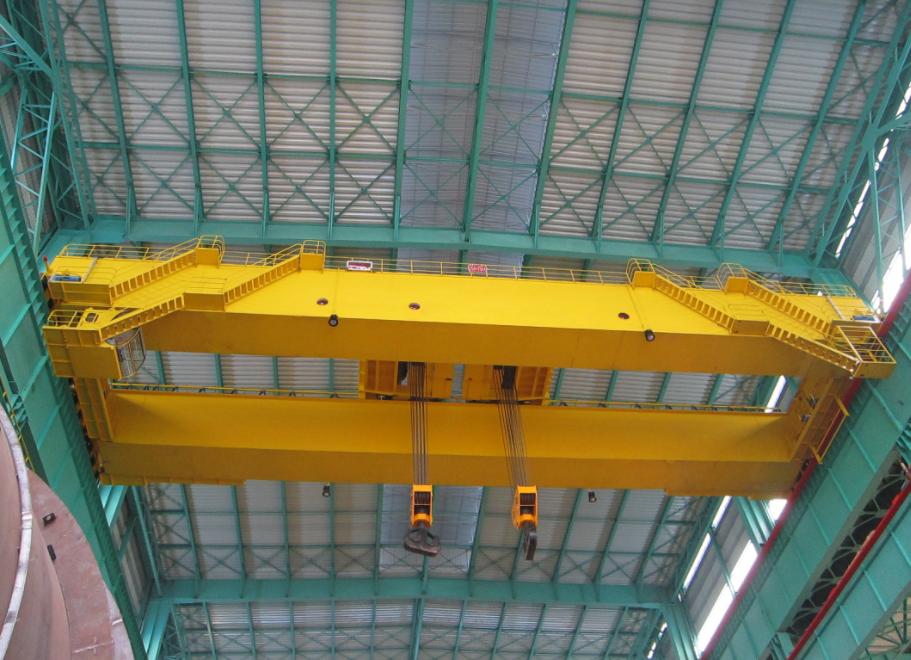1
0
0
Innovations in Double Girder Overhead Crane Design and Specifications
9
0
Double girder overhead cranes are a cornerstone in industries that demand heavy-duty material handling. From steel production to power generation, their ability to lift massive loads with precision makes them indispensable. Over the years, significant innovations in their design and specifications have transformed these cranes, enhancing their efficiency, safety, and adaptability. This article explores the latest innovations shaping double girder overhead cranes and how they benefit modern industries.
Advanced Structural Designs
One of the most notable innovations in double girder overhead cranes is the use of advanced materials and optimized structural designs. Traditional cranes were often bulky, with designs focused solely on load-bearing capacity. Modern cranes, however, employ:
These advancements improve the crane’s structural integrity, enhance performance, and reduce wear and tear over time.

Intelligent Control Systems
Gone are the days of purely manual controls. Today’s double girder overhead cranes feature intelligent control systems that revolutionize their operation:
[ol]
Automated and Semi-Automated Operation: Advanced software enables automated load lifting, positioning, and lowering, reducing human error and increasing operational efficiency.
Wireless Remote Controls: Operators can control cranes from a safe distance using wireless systems, improving safety and flexibility.
Variable Frequency Drives (VFDs): These allow smooth and precise control of speed during operation, reducing mechanical stress and improving accuracy.
Integration with IoT: IoT-enabled cranes can collect and transmit data on usage, performance, and maintenance needs, helping industries transition to predictive maintenance.
[/ol]
Enhanced Lifting Mechanisms
The lifting mechanism is at the heart of any crane, and innovations in this area have brought significant improvements in capacity, speed, and safety:
Anti-Sway and Load Stabilization Technology
Load sway has always been a challenge in crane operation, especially in environments requiring precise material placement. Innovations in anti-sway technology have significantly improved load stability:
These innovations reduce operation time and enhance safety, particularly in industries like shipbuilding and power generation, where precision is paramount.
Eco-Friendly and Energy-Efficient Designs
Environmental sustainability is a growing priority in industrial operations, and crane manufacturers are responding with greener solutions:
These eco-friendly features not only align with sustainability goals but also deliver long-term cost savings for businesses.
Safety Innovations
Safety remains a top priority in crane design, and advancements in safety features are pivotal in minimizing workplace accidents:
These features provide peace of mind to operators and reduce liability for businesses.
Customization and Modular Designs
Modern industries require cranes tailored to specific operational needs. Innovations in customization and modular designs make double girder cranes more versatile:
Integration with Industry 4.0
The advent of Industry 4.0 has brought digital transformation to the crane industry. Double girder overhead cranes now incorporate advanced technologies that integrate seamlessly into smart factories:
Applications of Innovative Double Girder Overhead Cranes
These innovations have expanded the applications of double girder overhead cranes across industries. Key examples include:
Conclusion
Innovations in double girder overhead crane design and specifications have redefined what these cranes can achieve. From intelligent control systems to energy-efficient motors and anti-sway technology, these advancements address industry challenges and open up new possibilities. By investing in modern double girder overhead cranes, businesses gain not only improved performance and safety but also the tools to meet the demands of an ever-evolving industrial landscape.
As industries continue to innovate, the future of double girder overhead cranes looks promising, with smarter, greener, and safer designs leading the way.
Advanced Structural Designs
One of the most notable innovations in double girder overhead cranes is the use of advanced materials and optimized structural designs. Traditional cranes were often bulky, with designs focused solely on load-bearing capacity. Modern cranes, however, employ:
- High-Strength Alloys: These reduce the overall weight of the crane without compromising its load capacity, making it easier to install and maintain.
- Finite Element Analysis (FEA): This technology allows engineers to design cranes with precision, optimizing girder profiles for maximum strength and minimal weight.
These advancements improve the crane’s structural integrity, enhance performance, and reduce wear and tear over time.

Intelligent Control Systems
Gone are the days of purely manual controls. Today’s double girder overhead cranes feature intelligent control systems that revolutionize their operation:
[ol]
[/ol]
Enhanced Lifting Mechanisms
The lifting mechanism is at the heart of any crane, and innovations in this area have brought significant improvements in capacity, speed, and safety:
- High-Performance Wire Ropes: New-generation ropes are more durable and resistant to wear, ensuring longer service life.
- Dual Hoist Systems: Some double girder cranes now include dual hoists for synchronized lifting, which is essential for handling long or unwieldy loads.
- Compact Trolleys: Modern trolley designs minimize space usage while maximizing lifting efficiency, making cranes suitable for facilities with limited clearance.
Anti-Sway and Load Stabilization Technology
Load sway has always been a challenge in crane operation, especially in environments requiring precise material placement. Innovations in anti-sway technology have significantly improved load stability:
- Electronic Sway Control: Advanced algorithms automatically adjust the crane’s movement to minimize sway during acceleration and deceleration.
- Laser-Guided Systems: Lasers help detect and stabilize loads in real-time, ensuring accurate placement even in challenging conditions.
These innovations reduce operation time and enhance safety, particularly in industries like shipbuilding and power generation, where precision is paramount.
Eco-Friendly and Energy-Efficient Designs
Environmental sustainability is a growing priority in industrial operations, and crane manufacturers are responding with greener solutions:
- Energy Recovery Systems: Modern cranes can capture and reuse energy generated during braking, reducing power consumption.
- Lightweight Components: Using advanced materials to reduce overall weight decreases energy requirements during operation.
- Efficient Motors: Cranes now come equipped with energy-efficient motors that comply with global environmental standards, reducing operational costs and emissions.
These eco-friendly features not only align with sustainability goals but also deliver long-term cost savings for businesses.
Safety Innovations
Safety remains a top priority in crane design, and advancements in safety features are pivotal in minimizing workplace accidents:
- Advanced Overload Protection: Sensors monitor the crane’s load in real-time and prevent operation if the load exceeds safe limits.
- Collision Avoidance Systems: Cranes equipped with proximity sensors and cameras can automatically halt or adjust movement to avoid collisions with obstacles or personnel.
- Emergency Stop Features: Modern cranes include advanced emergency stop systems that activate instantly in the event of a malfunction.
These features provide peace of mind to operators and reduce liability for businesses.
Customization and Modular Designs
Modern industries require cranes tailored to specific operational needs. Innovations in customization and modular designs make double girder cranes more versatile:
- Tailored Dimensions: Cranes can be customized for span, lifting height, and load capacity to fit unique applications.
- Modular Construction: Modular components make installation and upgrades easier, reducing downtime during assembly or maintenance.
- Adaptable Configurations: Cranes can be configured for specialized applications, such as hazardous environments or high-temperature conditions.
Integration with Industry 4.0
The advent of Industry 4.0 has brought digital transformation to the crane industry. Double girder overhead cranes now incorporate advanced technologies that integrate seamlessly into smart factories:
- Predictive Maintenance: Sensors monitor the crane’s condition and alert operators to maintenance needs before failures occur.
- Data Analytics: Real-time data analysis helps optimize operations, track performance metrics, and reduce inefficiencies.
- Remote Monitoring: Cloud-based systems allow managers to monitor crane operations and diagnostics from anywhere, ensuring continuity and performance.
Applications of Innovative Double Girder Overhead Cranes
These innovations have expanded the applications of double girder overhead cranes across industries. Key examples include:
- Steel Mills: Advanced cranes handle heavy steel coils and molten metal safely and efficiently.
- Power Plants: Enhanced safety features and precision make these cranes indispensable for lifting turbines and transformers.
- Shipbuilding: Anti-sway technology and dual hoists ensure seamless lifting of ship sections and engines.
- Aerospace: Customized designs handle delicate and oversized aircraft components with precision.
Conclusion
Innovations in double girder overhead crane design and specifications have redefined what these cranes can achieve. From intelligent control systems to energy-efficient motors and anti-sway technology, these advancements address industry challenges and open up new possibilities. By investing in modern double girder overhead cranes, businesses gain not only improved performance and safety but also the tools to meet the demands of an ever-evolving industrial landscape.
As industries continue to innovate, the future of double girder overhead cranes looks promising, with smarter, greener, and safer designs leading the way.
Signatur
